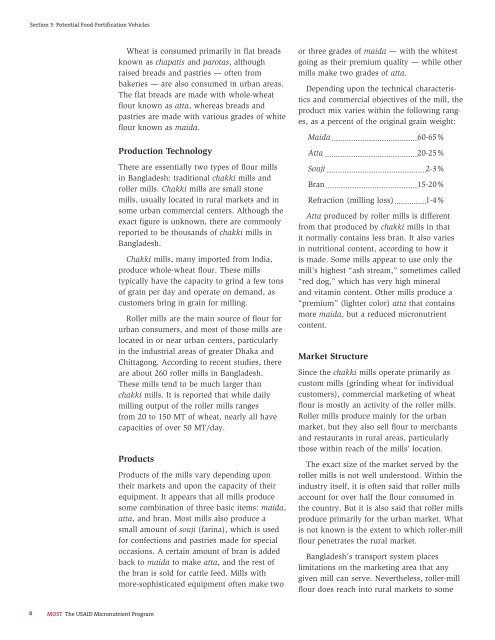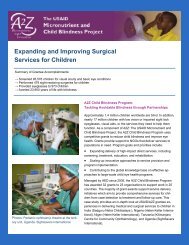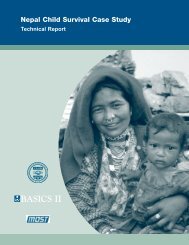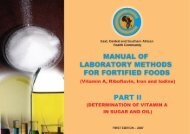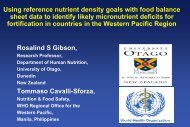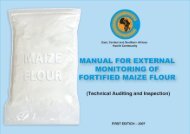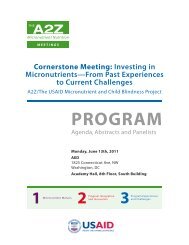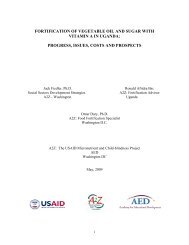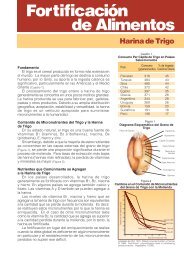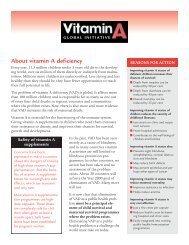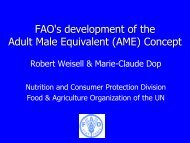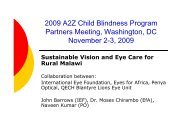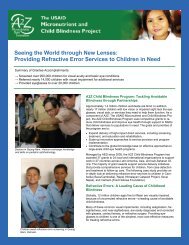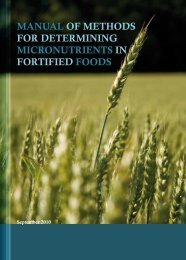Elements of a National Food- Fortification Program for Bangladesh
Elements of a National Food- Fortification Program for Bangladesh
Elements of a National Food- Fortification Program for Bangladesh
You also want an ePaper? Increase the reach of your titles
YUMPU automatically turns print PDFs into web optimized ePapers that Google loves.
Section 3: Potential <strong>Food</strong>-<strong>Fortification</strong> VehiclesWheat is consumed primarily in flat breadsknown as chapatis and parotas, althoughraised breads and pastries — <strong>of</strong>ten frombakeries — are also consumed in urban areas.The flat breads are made with whole-wheatflour known as atta, whereas breads andpastries are made with various grades <strong>of</strong> whiteflour known as maida.Production TechnologyThere are essentially two types <strong>of</strong> flour millsin <strong>Bangladesh</strong>: traditional chakki mills androller mills. Chakki mills are small stonemills, usually located in rural markets and insome urban commercial centers. Although theexact figure is unknown, there are commonlyreported to be thousands <strong>of</strong> chakki mills in<strong>Bangladesh</strong>.Chakki mills, many imported from India,produce whole-wheat flour. These millstypically have the capacity to grind a few tons<strong>of</strong> grain per day and operate on demand, ascustomers bring in grain <strong>for</strong> milling.Roller mills are the main source <strong>of</strong> flour <strong>for</strong>urban consumers, and most <strong>of</strong> those mills arelocated in or near urban centers, particularlyin the industrial areas <strong>of</strong> greater Dhaka andChittagong. According to recent studies, thereare about 260 roller mills in <strong>Bangladesh</strong>.These mills tend to be much larger thanchakki mills. It is reported that while dailymilling output <strong>of</strong> the roller mills rangesfrom 20 to 150 MT <strong>of</strong> wheat, nearly all havecapacities <strong>of</strong> over 50 MT/day.ProductsProducts <strong>of</strong> the mills vary depending upontheir markets and upon the capacity <strong>of</strong> theirequipment. It appears that all mills producesome combination <strong>of</strong> three basic items: maida,atta, and bran. Most mills also produce asmall amount <strong>of</strong> souji (farina), which is used<strong>for</strong> confections and pastries made <strong>for</strong> specialoccasions. A certain amount <strong>of</strong> bran is addedback to maida to make atta, and the rest <strong>of</strong>the bran is sold <strong>for</strong> cattle feed. Mills withmore-sophisticated equipment <strong>of</strong>ten make twoor three grades <strong>of</strong> maida — with the whitestgoing as their premium quality — while othermills make two grades <strong>of</strong> atta.Depending upon the technical characteristicsand commercial objectives <strong>of</strong> the mill, theproduct mix varies within the following ranges,as a percent <strong>of</strong> the original grain weight:Maida 60-65%Atta 20-25%Souji 2-3%Bran 15-20%Refraction (milling loss) 1-4%Atta produced by roller mills is differentfrom that produced by chakki mills in thatit normally contains less bran. It also variesin nutritional content, according to how itis made. Some mills appear to use only themill’s highest “ash stream,” sometimes called“red dog,” which has very high mineraland vitamin content. Other mills produce a“premium” (lighter color) atta that containsmore maida, but a reduced micronutrientcontent.Market StructureSince the chakki mills operate primarily ascustom mills (grinding wheat <strong>for</strong> individualcustomers), commercial marketing <strong>of</strong> wheatflour is mostly an activity <strong>of</strong> the roller mills.Roller mills produce mainly <strong>for</strong> the urbanmarket, but they also sell flour to merchantsand restaurants in rural areas, particularlythose within reach <strong>of</strong> the mills’ location.The exact size <strong>of</strong> the market served by theroller mills is not well understood. Within theindustry itself, it is <strong>of</strong>ten said that roller millsaccount <strong>for</strong> over half the flour consumed inthe country. But it is also said that roller millsproduce primarily <strong>for</strong> the urban market. Whatis not known is the extent to which roller-millflour penetrates the rural market.<strong>Bangladesh</strong>’s transport system placeslimitations on the marketing area that anygiven mill can serve. Nevertheless, roller-millflour does reach into rural markets to some8 MOST The USAID Micronutrient <strong>Program</strong>


